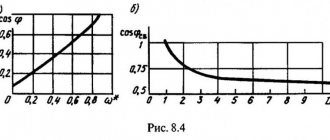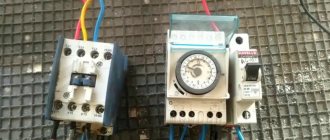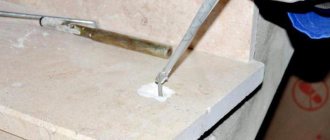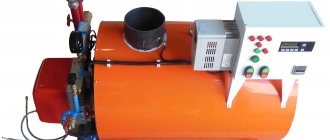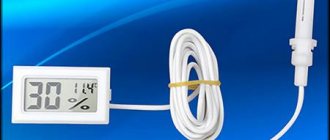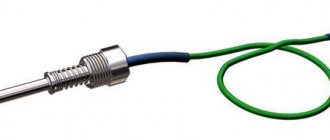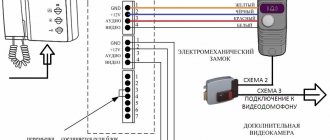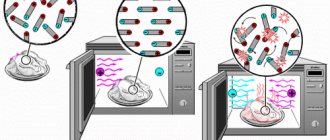- compressive hardness;
- extensibility;
- tear resistance;
- bending resistance;
- shearing force.
The use of concrete that is resistant to mechanical stress and aggressive environments is the key to the durability and strength of buildings. Therefore, in construction, great importance is attached to testing concrete for strength.
What does a sclerometer consist of?
The term "sclerometer" means "hardness meter". Structurally, the device consists of 22 elements. In addition to the indenter (impact plunger) and housing, the device includes:
- body cone;
- guide rods with slider;
- a button that performs the function of a corkscrew;
- striker with a given mass;
- guides the movement of the indenter; the striker rod;
- washer for fixing the striker;
- cap;
- back cover of the sclerometer;
- felt ring.
Some models are equipped with a fuse and a control nut, as well as 4 springs (compression, impact, safety, fixing). A coupling screw, a pin, a Schmidt scale, and a display are required.
Working principle of the Schmidt hammer
A working Schmidt sclerometer shows the strength of concrete when an impact is made on its surface followed by an elastic rebound. How resistant the tested concrete is to destructive mechanical influences is known from statistical data.
The device measures the shock pulse that occurs when a mechanical load is applied to the solid surface of the test object. A simplified algorithm for the operation of the device looks like this:
- the impact plunger (indenter) is pressed against the surface of the concrete, where there are no metal parts (reinforcement);
- due to the spring, the indenter hits the test surface;
- a system of four springs returns the striker (plunger) to its original position through free rebound.
Methods for testing the strength of concrete
At the moment, there are two main methods for determining the strength of concrete: using destructive or non-destructive testing. Mechanical non-destructive testing methods are based on the relationship of concrete strength with other mechanical properties, such as shearing force, peel strength and compressive hardness. Depending on the type of property being assessed, the following non-destructive testing methods are often used:
- separation;
- plastic deformation;
- rib chip;
- elastic rebound.
Read also: DIY wood engraving machine
The choice of testing method depends on the size and shape of the products, the purpose of the activities being carried out, the requirements for the accuracy of the results obtained and the degree of convenience of testing. In world practice, the most widely used device for determining strength characteristics is the Schmidt hammer. In our country it is often called a sclerometer, which translated from Greek means “hardness meter” .
The Schmidt hammer was developed in 1948 by Swiss engineer Ernst Schmidt. It was Schmidt's hammer that first made it possible to measure the strength of concrete structures at the construction site.
Types of sclerometers
The degree of compressive strength of concrete is shown on a digital scale. The number characterizes the rebound of the striker to a certain height. The stronger the rebound, the harder the concrete.
There are several types of Schmidt hammer - they differ in the principle of operation (mechanical or ultrasonic impact on the test object). The second common classification is based on the use of impact energy, measured in J.
Mechanical and ultrasonic devices
A mechanical type device, intended for studying reinforced concrete or concrete structures, looks like a cylinder with a percussion mechanism made of a repelling spring, an indicator scale, and a striker placed inside.
The sensitivity of the device is from 5 to 50 MPa.
Electronic Schmidt ultrasonic hammer is equipped with two types of electronic units:
- built-in;
- external.
This design of the device is preferable. Firstly, the results do not need to be recorded - they are stored in the unit’s memory for 100 days. The maximum memory reserve is 1000 readings. The hammer is suitable for connecting to a computer due to special ports and connectors.
The sensitivity of the electronic modification is much higher than that of its mechanical counterpart. The device recognizes strength in the range from 5 MPa to 120 MPa.
Impact energy classification
Based on the impact force, there are 4 main modifications of the sclerometer:
- Modification 1 - the least “powerful” MS 20. The impact energy value does not exceed 196 KJ.
- Modification 2 – pendulum type RT, operating in 2 planes. Impact power - from 200 to 500 KJ;
- Modification 3 - MSh 75 (type L). The impact force is 735 KJ;
- Modification 4 - MSh-225 (type N). The most powerful option of all - with impact energy up to 2207 J and sensitivity from 10 to 70 MPa.
Devices of different power and purposes have different purposes. MSh 20 measures the strength of mortar for brickwork, RT is necessary for measuring the strength of a newly laid cement-sand screed. MSh-225 (type N) is designed for measuring the strength of brick and concrete up to 100 mm thick. The purpose of using MSh 75 (type L) is to determine the reliability of walls with a thickness of at least 70 mm.
How to determine the strength of concrete
Construction is a rather labor-intensive process.
To eliminate unnecessary costs and not waste time, you should take good care of the quality of materials. First of all, you need to think about how to check the brand of concrete mix. The ordered solution does not always correspond to the characteristics specified in the document. If the added raw materials for making concrete do not meet the proper proportions, the quality of the solution automatically changes. To accurately recognize the brand, it is necessary to conduct a quality assessment.
Concrete grade is an indicator showing the compressive strength. Grades M300-400 are suitable for construction. M100-250 have minimal strength and are suitable only for auxiliary work. Much depends on the chosen supplier. It is worth looking for trusted companies with a good reputation that can provide the necessary documents for the products offered.
Determining the grade of concrete can be done using different methods:
- Laboratory examination;
- Ultrasonic method;
- Self-check.
Each method varies in accuracy percentage and has certain subtleties.
Contact testing is carried out using two methods. The first is with the help of professional equipment - a sclerometer. The device determines strength using a shock pulse. The sclerometer can be mechanical or electronic, and its price ranges from 10 to 35 thousand; a purchase for one-time use is simply not rational for the average buyer.
Sclerometer
The second method involves sending the sample to a laboratory. First you need to carry out a number of manipulations:
- Prepare a wooden box with a volume of 15 cm³;
- Pour the purchased solution into the mold directly from the concrete mixer tray, pre-moisten the box with water. Compact the poured solution by making several punctures with reinforcement;
- Place the sample for 28 days in the same conditions as the main structure;
- The frozen sample is taken to the laboratory for testing. Evaluation can be made at intermediate stages of setting (3, 7 and 14 days).
The examination will issue a conclusion on the study of a sample of this brand and its compliance with established standards.
Testing samples in the laboratory
Ultrasonic devices, in addition to strength testing, are used for flaw detection. The speed of propagation of ultrasound in concrete reaches 4500 m/s.
The calibration relationship between the speed of sound propagation and the compressive strength of concrete is fixed in advance for each mixture composition. In the case of using 2 dependencies for concrete of alternative or unknown compositions, inaccuracy may arise in determining the strength. The “strength-ultrasound speed” relationship is affected by a number of factors, the fluctuations of which in this case must be taken into account when using ultrasonic testing:
- Method for producing concrete mortar;
- Quantity and grain composition;
- Change in cement consumption by more than 30%;
- Possible cavities, cracks and defects in the finished structure;
- Concrete compaction level.
Ultrasonic testing is suitable for mass testing of structures of any shape, as well as for continuous monitoring of strength gain or loss. The disadvantage of the method is the error in the transition from acoustic to strength indicators. Ultrasonic equipment should not be used to check the quality of high-strength grades; the permissible range is limited to classes B7.5...B35 (10-40 MPa), in accordance with GOST 17624-87.
Testing in a laboratory or using special means does not always pay off. This applies to cases where a small building is being built on private property. The poured and hardened solution can be checked at home in several ways. If it does not meet the necessary requirements, you can use a paid examination and recover damages from the supplier.
Carefully examine the frozen structure. It should be smooth; the presence of patterns indicates non-compliance with the filling rules. Such a solution would most likely freeze, which would significantly reduce its strength. In fact, concrete grade M300 will have the same properties as M200-250.
Voice test
You can check by the sound of the impact. To do this, take a hammer or a piece of metal pipe weighing no more than 0.5 kg. The ringing tone when striking is important here. A dull sound indicates low strength and poor sealing. And if cracks or crumbs appear, it is necessary to completely or partially replace the structure.
Visual assessment
The method involves checking the characteristics of the solution upon acceptance. The following points can be highlighted:
- Color - a high-quality mixture is gray with a bluish tint; if yellowness is clearly visible in the cement laitance, the mixture contains clay impurities or slag additives. A brown or red color is characterized by an excess of sand or aggregate in an unacceptable amount; it is wiser to avoid a solution with an uneven shade altogether;
- The correct consistency is homogeneous, without lumps or clots and resembles moistened soil;
- Excess water is determined by pouring a small amount of the mixture into the pit; the result should be a cake without layers or cracks;
- A purchased solution of poor quality begins to separate during transportation; the mixture cannot be removed with a shovel or fed through a hose.
If a mixer is delivered, the quality of concrete can only be determined without inspection using the documents provided. In this case, everything depends on the integrity of the seller.
A hammer and chisel are the simplest answer to the question of how to check the quality of poured concrete. To do this, an impact test is carried out using a hammer. A chisel is placed on the surface of a completely dried foundation and a blow is struck with medium force. If the resulting dent exceeds 1 cm, strength class B5 (M75), less than 0.5 cm - B10 (M150). A small dent remains on B15-25 (M200-250), and a minor mark appears on B25 (M350).
All the methods described have their advantages and disadvantages; to ensure the accuracy of the result, you should seek help from specialists. Laboratory, ultrasound and shock-impulse studies are more reliable and comprehensive. Quality directly depends on the characteristics of the constituent components, compliance with proportions, storage and transportation conditions. Therefore, you can protect yourself by choosing a trusted supplier with a good reputation, this will significantly reduce the risk of problems in the future.
READ MORE: Hotpoint Ariston stoves, gas and electric stove with oven and other models, operating instructions and selection of spare parts
The solutions produced by our concrete plant provide standard strength to concrete products. Using mixtures, high-quality pouring of foundations and monolithic building structures is performed. Concrete of any grade can withstand tests and the maximum number of quality checks for cement and fillers, in mixtures and finished structures.
We offer mortars and concrete from the manufacturer with standard indicators that meet the requirements of GOST. Strict compliance with standards is ensured by the use of special additives and plasticizers that meet the requirements for water resistance, frost resistance, etc. But is it possible to assess the quality of concrete during pouring or during setting without laboratory testing?
It is possible to accurately find out certain characteristics of a mixture only in a laboratory that operates at every large enterprise. After all, concrete M350 or M400 looks almost the same as M100. When ordering a batch, the client is forced to trust the passport and documents for the ordered delivery, which are presented by the mixer driver. To do this, you need to carefully review the certificates provided.
Next, you should pay attention to the brand indicated by the manufacturer, as well as the time when the invoices were issued. After all, a vehicle makes many trips per day, and the documents presented for unloading may not correspond to the shipment actually delivered to the construction site. There are also signs by which experienced craftsmen can roughly evaluate the brand.
- Pay attention to the shade of the mixture. Light brown indicates an excess of sand, reddish indicates slag additives or the presence of clay. The solution should be a uniform, gray shade. However, the change in color of the mixture may depend on the presence of various additives.
- The quality of concrete can be determined by casting a portion into a separate container (bucket, wetted mold). No puddles of water should appear on the solution.
- When pouring, no delaminations or cracks should form on the surface.
- If the concrete falls like a cake, and cement laitance is poured separately, this can be considered a sign of poor quality of the mixture provided.
But a concrete mixture can only be accurately tested in a specialized laboratory, and most often after it has gained strength. Therefore, when pouring the main foundation, it is necessary to cast cubes measuring 100x100x100 mm and leave to harden under standard conditions. After full ripening (28 days), samples should be sent to the laboratory for testing.
To evaluate the quality of the resulting product, there are several methods that experienced builders know.
- Carefully inspect the resulting surface of the product or foundation. High grade concrete must have a smooth surface, without pores or layers. If pouring work was carried out at low temperatures in winter, characteristic patterns should not appear on the surface, which indicate freezing of the mixture. The presence of patterns indicates freezing during pouring; they lower the concrete grade by 70-100 points (from M300 to M200-250);
- Using a hammer that weighs no more than 500 g, tap the foundation after reaching 70% of the strength characteristics. The sound should be clear. If, with a ringing sound during an impact, hammer marks remain on the surface, this indicates that the density of the concrete is 150-200 kg/cm2. A dull sound indicates a low grade of the mixture, and indicates that the strength does not exceed 100 kg/cm2. And if, upon impact, cracks form on the surface or the material crumbles, it is recommended to re-fill.
By hitting the chisel with a light-weight hammer (300-400 grams), you can also find out the quality of the concrete. It is necessary to evaluate how and to what depth the chisel plunges into concrete during impacts of average force.
- If the tip plunges deeply and easily without hitting crushed stone or gravel, the grade is below M70.
- With an immersion depth of up to 5 mm, we can assume that the grade is equivalent to M70-M100.
- For concrete grades M100-M200, when a chisel hits the surface, only small thin layers are separated.
- If there are no marks left from the chisel at all or there is a shallow mark and there are no peelings at all, we can assume that the grade of concrete is higher than M200.
Schmidt hammer: instructions for use
The test begins by selecting a suitable area on the surface of the object. Then the device is pressed against the area of the object under study using an impact mechanism.
Smooth pressure is applied with both hands at once until the sound of the striker hitting the surface appears.
After the impact, a numerical value of the hardness indicator appears on the scale.
The relationship between the compressive force on concrete and its strength is as follows:
- the least durable fresh concrete can withstand pressure from 1 to 10 MPa;
- ordinary, hardened concrete - from 10 to 70 MPa;
- the hardened solution collapses under compression from 70 to 100 MPa;
- heavy-duty can withstand compression of more than 100 MPa.
For a hand-held meter to give a reliable result, take at least 9 measurements with a minimum distance between samples of 25 mm.
"Technical Tricks"
To avoid accidentally testing one area twice, the surface of the concrete is marked - for example, 9 squares are drawn.
Each concrete square is measured, recording the result for subsequent analysis. The measurement is not counted (to be repeated in another area) if the striker hits the surface hiding the void.
All 9 samples may be identical in size or may differ slightly. Data analysis is based on deriving the arithmetic mean from the results of 9 hits.
Do not use the device in difficult conditions that change the characteristics of the material (high/low temperatures, exposure to mechanical, thermal or chemical agents).
Standards for the Schmidt hammer Original SCHMIDT
| Proceq Manager Hello! My name is Yartsev Oleg. I am ready to answer your questions about Proceq products. If you want to place an order or ask a question, you can contact me by phone or email. |
|
|
Read also: What does a PWM controller look like?
